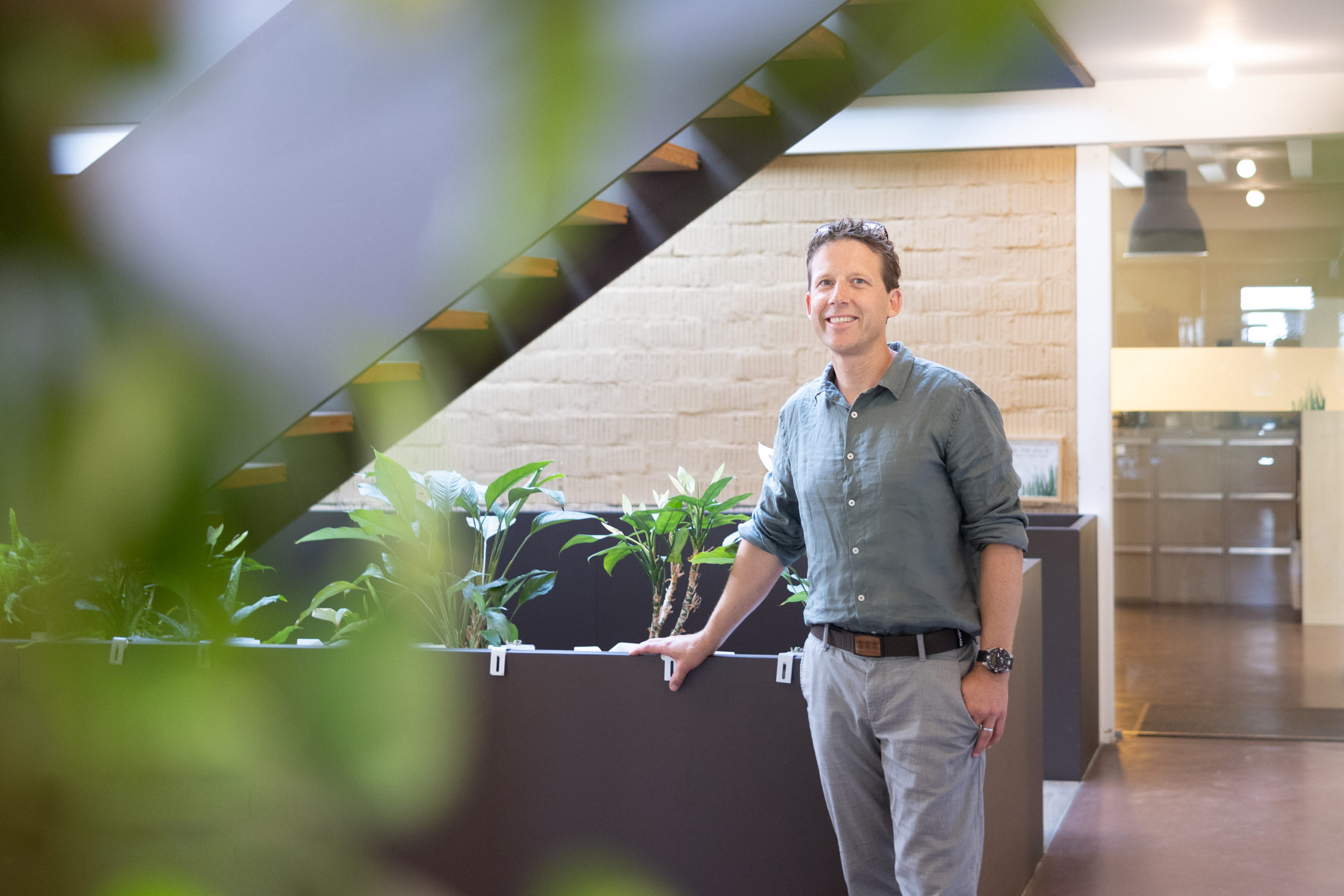Fabrice Macherel, Associate Director of Lutz Architects, in Green Offices, which is not only the company’s headquarters but also a fine example of environmentally responsible construction.

As far back as the early 1970s, the Fribourg-based Conrad Lutz was a vocal advocate of energy-efficient building design. Some saw him as a dreamer, others as a crank. But when the 1973 oil crisis hit, doubters soon realized that Lutz had been right all along. With the introduction in the late 1990s of the Minergie construction standard for low-energy buildings, Switzerland had finally started to treat the issue with the seriousness it deserved. The founder of Lutz Architects retired in 2017 but his successors continue to keep his pioneering spirit and innovative thinking alive. Fabrice Macherel, Associate Director of this illustrious architecture practice and a green architecture expert, shares some insights on the past, present and future of energy-efficient building design.
‘Green Offices’, the Lutz Architectes office, was built 16 years ago but remains a paragon of green construction. Why?
Our Minergie-P-Eco-certified office building, which also houses other companies, stands out for its very low environmental impact. It uses close to 90% less energy than a standard office building built in 2007, and there are several reasons why. For example, the building materials have low levels of embodied energy, and the property is fitted out with dry toilets and a rainwater collection system. As a winner of the Watt d’Or award in 2008 and the Prix Lignum in 2009, Green Offices is a great reference for our architecture firm.
The Prix Lignum recognizes innovative timber construction projects. It seems that you naturally prefer to work with wood.
It’s all about using the right materials for the job at hand. It is perfectly fine to use concrete if you’re laying foundations or building tunnels. However, as soon as you start building above ground, wood is better because it greatly reduces the level of CO2 emissions and could even be recycled once the structure reaches the end of its lifecycle. We need to start paying more attention to the embodied energy of building materials. Switzerland’s forests are still underexploited. Drawing energy exclusively from the sun, it takes the forests a little over one minute to produce enough timber to build a family home.
Would you agree that energy-efficient building design has never been more topical as it is now?
The climate and energy crises have led to a lot of media coverage on the subject. This should spur us on to fully commit to sustainability, especially since buildings guzzle nearly 50% of the energy consumed in Switzerland. Given the ambitious targets that Switzerland has set itself, the legal framework is going to become tighter, and we must not shy away from investing in energy efficiency, for both financial and ecological reason. Even water, which was long thought to be inexhaustible in Switzerland, could become much more expensive in the future, as has already happened with heating oil and electricity. Today, it is possible to construct passive buildings, i.e., buildings that generate more energy than they consume.
What about renovating existing buildings?
We absolutely need to do this. Sustainable construction is one thing, but renovating existing stock is quite another. One of our many collaborations in Switzerland and Europe is the ‘Coccum’ research project which our firm launched. Together with the Building Innovation Cluster (BIC), the Fribourg School of Engineering and Architecture and other private and public partners, we are working on developing a reproducible, standardized renovation technique to improve the envelope efficiency and airtightness of a building, while enhancing its architectural quality at the same time. The project has so far led to the first Minergie-P renovation in Western Switzerland of a 1950s rental property.
How do you see the future?
The major challenge will be to supply housing stock of sufficient quantity and quality for our rapidly growing population. We have already managed to turn a space that was originally designed for one household into a house that can accommodate two or three families without negatively impacting their quality of life and comfort. We also need to think about the flexibility and modularity of houses and apartments over time. More generally, we have to re-embrace circular economy thinking while re-designing urban spaces so that they are better thought out in terms of housing, mobility and infrastructure. Our motto sums it up: build today while thinking of tomorrow!
FRIBOURG – A CHAMPION OF ENERGY EFFICIENCY
The Fribourg-based start-up Yord wants us all to heat smarter. It has developed a solution that uses artificial intelligence to cut energy consumption by up to 40%. The solution has two components: a box which connects to the boiler, as well as a network of sensors that measure brightness, humidity, temperature and CO2 levels. But that’s not all: Yord’s solution is compatible with heating systems of all ages and types, and can be installed with no adjustments needed.
Fribourg is home to another energy efficiency champion: Ecco2, the leading Swiss provider in its field is the brains behind the multi-award-winning Building Intelligence solution. Its predictive heating control technology can be used even on large-scale real estate holdings and generates certified results in under two years. Whether you are a portfolio manager, property manager, heating technician or janitor, Ecco2 offers a range of tools – from customized dashboards to mobile applications – to suit any user profile.
Energy efficiency is also a public issue. The Cantonal Competence Center in Building Renovation CCRB, created in 2022, is a one-stop shop for anyone interested in or involved in renovation projects. Its many missions include acting as a facilitator between project partners; proposing simple, tried and tested solutions; and developing and adopting new types of implementation plans and business models.
